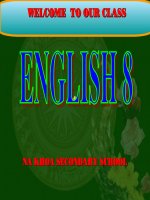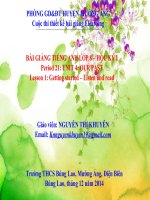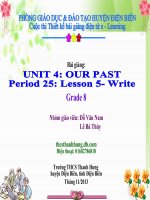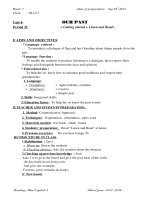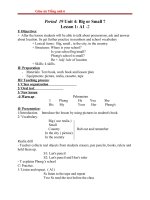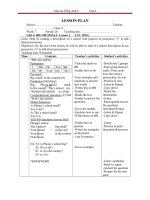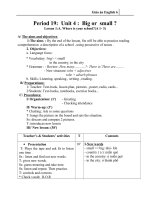Giáo án Tiếng Anh 8 Unit 4: Our past
Bạn đang xem bản rút gọn của tài liệu. Xem và tải ngay bản đầy đủ của tài liệu tại đây (169.02 KB, 26 trang )
GIÁO ÁN ENGLISH 8
UNIT 4: OUR PAST
LESSON 1: GETTING STARTED, LISTEN AND READ (P. 38, 39)
A. Aim: By the end of the lesson, students will be able to tell the activities people used to
do in the past.
B. Methods: Communicative approach
C. Teaching aids:
Teacher: textbook, poster, pictures
Students: textbook, notebook, pens, rulers.
D. Procedure:
I. Class organization: 1 minute
II. Revision: (5 minutes) WARM-UP
III. New lesson:
1. Setting the scene: Included in the WARM-UP
2. Main activities:
Teacher’s and students’ activities
On the board
WARM UP
- T asks students to look at the picture Chatting: GETTING STARTED
on p.38 and write the names of the
things that do not belong to the past.
- T gives feedback
- Expected answers:
+ the TV
+ the radio
+ the mobile phone
+ the light fixture
+ modern clothing / school uniforms.
PRE - READING
- T models 3 times and gets Ss
repeat
to I. Pre - teach vocabulary:
to
[synonym]
look
after
= to take care of
[example]
[example]
equipment
a
(n)
folk
tale
Ex: Cinderella, Tam Cam, Su tich trau cau, ...
[translation]
traditional
[explanation]
(adj)
Great-grandma
- T sets the scene: “You are going to
read a conversation between Nga and = the mother of your grandmother
her grandma about the childhood of her
Checking vocabulary: What and where
grandma.” Please read the statements
and guess which is true, which is false. II. True - False prediction
a. Nga is used to live on a farm.
b. Nga's grandma didn't go to school.
- T asks Ss to read the dialogue c. She has an easy and happy life when she was
between Nga and her Grandma and young.
check their prediction.
d. There wasn't any modern equipment at her
- Ss correct the false statements.
time.
e. "The lost shoe" is a short story.
WHILE - READING
I. Reading the text
- T asks Ss to work in pairs to find out
the answers to these questions.
Guess
Correct
a.
F
b.
T
c.
F
d.
F
e.
T
- T asks Ss to practice asking and
- Correction:
answering the questions
a. Grandma used to live on farm
- Ss work in pairs – open pairs – closed
pairs
c. She had a hard life.
e. It is an old folk tale
II. Comprehension questions
1. Where did Nga's grandmother use to live?
2. Why didn't she go to school?
3. What did Nga's Great Grandma do?
4. What did Nga's great grandmother and great
grandfather do after dinner?
5. What did Nga ask her grandma to do at the
end of the conversation?
- Expected answers:
1. She used to live on a farm.
2. Because she had to stay at home and her
Mom to look after her younger brothers and
sisters.
3. She used to cook the meals, clean the house
and wash the clothes.
- T has Ss read the statements in part 3
4. Her great grandma used to light the lamp and
on p.39 and decide which is a fact and
her great grandfather used to tell stories.
which is an opinion.
5. She asked her grandma to tell her the tale
- T asks Ss to work in groups,
"The lost shoe"
discussing the topics.
III. Fact or opinion?
F O
a. I used to live on a farm
X
b. There wasn't any electricity
X
c. Mom had to do everything without X
the help of modern equipment.
- T asks Ss to do the survey in groups
of 4.
d. My father used to tell upper
X
secondary schools stories.
- T models some questions to check:
e. The best one was the lost shoe.
"Who used to get up late / ride bicycle
too fast, ...?"
f. Traditional stories are great.
X
X
POST - READING
Who used to ...?
- get up late
- ride bicycle too fast
- go to school late
- eat too much candy
name
IV. Consolidation: (2 minutes)
- T asks students to summarize the conversation between Nga and her Grandma.
V. Homework
- Prepare Speak - Language focus 4
- Do exercise 1 + 2 in workbook
UNIT 4: OUR PAST
LESSON 2: SPEAK 1, 2 - LANGUAGE FOCUS 4 (P. 40, 45)
A. Aim: By the end of the lesson, students will be able to use USED TO to talk about the
things they used to do
B. Methods: Communicative approach
C. Teaching aids:
Teacher: textbook, poster, pictures
Students: textbook, notebook, pens, rulers.
D. Procedure:
I. Class organization: 1 minute
II. Revision: (5 minutes) WARM-UP
III. New lesson:
1. Setting the scene: Included in the WARM-UP
2. Main activities:
Teacher’s and students’ activities
On the board
WARM UP
- T divides class into 2 teams, each Jumbled words
team take turns to go to the BB and
1- rieletcicty
= electricity
write the meaningful words
2- menttaenterin = entertainment
- T gives feedback
3- rkmaet
= market
4- permasuekt
= supermarket
5- aiiotrdtnal
= traditional
6- aetrvl
= travel
- T recalls the conversation between
Nga and her grandma then asks:
"Where did Nga's grandma always
live?"
Form:
- Ss listen to the T and answer: "She
always lived on a farm"
+ T: "another word for always lived"
+ Ss: "used to live "
- T asks Ss the usage and meaning of
USED TO
PRESENTATION
S + USED TO + infinitive
S + didn’t use to + infinitive
Did + S + use to + infinitive?
Yes, S + did / No, S + didn’t
Usage: used to express a past habit, or an
action usually happened in the past.
Meaning: đã thường làm gì
- T asks Ss to use USED TO to make
Example:
questions and answer.
+ Where did Nga's grandma use to live?
+ She used to live on a farm.
- T models two cues then ask Ss to
repeat chorally then individually.
PRACTICE
Word - cue drill
- T asks Ss to practice asking and Model sentences:
answering.
1. live / Hue / Hanoi
- Open pairs – closed pairs
Did you use to live in Hue?
No. I used to live in Hanoi.
2. Have / long hairs / short hairs
3. Get up / late / early
4. Walk to school / bicycle
5. Study / evening / early morning
- T has Ss compare 2 pictures on p.40,
PRODUCTION
using USED TO to talk about the
- Expected answers:
actions in the past.
a. Where did they live in the past? And now?
- T elicits some ideas so that Ss can talk
about them: house, travel, electricity, - People used to live in small houses. Now they
work, entertainment and school.
live in big houses and buildings.
- Ss work in pairs, answer the b. How did they travel?
questions.
- People used to walk. Now, they can go by
- T gives feedback
cars or motorbikes.
c. What's about the electricity?
- Now, there is electricity everywhere.
d. What's about their life / work?
- People used to work hard all the time. Now,
they have a lot of time for entertainment.
e. Did children use to go to school?
- Most children used to stay at home. Now,
they all go to school.
f. What's about their entertainment?
- Children used to play traditional games such
as hide and seek, skip rope ... outdoors. Now,
they have a lot of modern games - video games.
IV. Consolidation: (2 minutes)
- T asks students to state the form, usage and meaning of USED TO, give an example.
V. Homework
- Write about the things you used to do last year.
Ex: Last year, I used to get up late. Now, I get up very early and do morning exercises
- Do exercise 3 + 4 in workbook.
- Prepare READ
UNIT 4: OUR PAST
LESSON 3: READ 1 -2 (P. 41, 42)
A. Aim: By the end of the lesson, students will be able to understand and retell the story
"The lost shoe"
B. Methods: Communicative approach
C. Teaching aids:
Teacher: textbook, poster, pictures
Students: textbook, notebook, pens, rulers.
D. Procedure:
I. Class organization: 1 minute
II. Revision: (5 minutes) WARM-UP
III. New lesson:
1. Setting the scene: Included in the WARM-UP
2. Main activities:
Teacher’s and students’ activities
On the board
WARM UP
- T divides class into 2 teams, each Brainstorming:
team take turns to go to the BB and
- One-hundred-section bamboo
write the names of some folk tales that
they have read.
- Tam Cam
- Seven - mile shoe
- Snow White and 7 dwarfs
- The Frog Prince
- How the tiger got his stripes
- T gives feedback
- The Lost Shoe
PRE - READING
- T models 3 times and gets Ss to I. Pre - teach vocabulary:
repeat
be
cruel
[translation]
to
(adj)
= unkind
- upset (adj)
[synonym]
= worried, sad, unhappy
[translation]
fairy
(n)
- magical (adj) magically (adv)
- rag
to
[translation]
[realia]
fall
in
love
- immediately (adv)
with
(= at once)
- T sets the scene: “You are going to
Checking vocabulary: Slap the board
read a fairy tale about Little Pea – a
poor girl living with her step mother, II. True - False predictions
now read the statements and guess
1. Little Pea's father is a poor farmer.
which is true, which is false.
2. Her father got married again after his wife
died.
3. Her new mother was beautiful and nice to her.
4. She worked hard all day.
- T asks Ss to read the story "The Lost
5. She didn’t have new clothes to take part in the
Shoe" on p. 41 and check their
festival.
prediction.
- T asks Ss to correct the false
statements.
WHILE - READING
I. Reading the text
Guess Answer Correction
- T asks Ss to work in pairs to find out
the answers of these questions.
1.
T
2.
T
3.
F
4.
T
5.
F
Her new mother was
cruel to her.
A fairy gave
beautiful clothes.
her
II. Comprehension questions
1. Who was Little Pea?
2. What did Stout Nut's mother make Little Pea
- Ss work in pairs and find the do all day?
answers
3. How did Little Pea get her new clothes?
- T asks Ss to practice asking and
4. Whom did the Prince decide to marry? why?
answering the questions: open pairs –
5. Is it a true story? How do you know?
closed pairs
- Expected answers:
1. She was a poor farmer's daughter.
2. She made her do the chores all day.
3. Before the festival started, a fairy appeared
and magically changed her rags into beautiful
clothes.
4. He decided to marry Little Pea because the
- T asks Ss to work in pairs, filling the shoe (which the Prince was keeping) fitted her.
blanks with suitable words from the
5. (Ss answer themselves.)
story.
III. Gap filling: (p.42)
Complete the sentences with words from the
story.
- Expected answers:
a. farmer - b. died - c. had/used, again - d.
- T asks Ss to tell the story again in marry / choose - e. new - f. lost
details.
POST - READING
Retell the story
IV. Consolidation: (2 minutes)
- T asks students to state the main points of the story
V. Homework
- Rewrite the story
- Do exercise 5 + 6 in workbook.
UNIT 4: OUR PAST
LESSON 4: LISTEN AND LANGUAGE FOCUS 1 -2 (P. 41, 44)
A. Aim: By the end of the lesson, students will be able to understand the main idea of a
story by listening and further practice in Past Simple Tense.
B. Methods: Communicative approach
C. Teaching aids:
Teacher: textbook, poster, pictures
Students: textbook, notebook, pens, rulers.
D. Procedure:
I. Class organization: 1 minute
II. Revision: (5 minutes) WARM-UP
III. New lesson:
1. Setting the scene: Included in the WARM-UP
2. Main activities:
Teacher’s and students’ activities
On the board
WARM UP
- T prepares 11 cards with numbers on Pelmanism
one side and the verbs on the other.
- T sticks the cards on the BB so that
the Ss can only see the numbers,
makes sure the verbs are mixed up.
- T divides the class into 2 teams.
Each team chooses 2 numbers.
- T turns the cards over, if they match
that team gets 1 mark. If not, T turns
the cards over again asks the next
team. Continue until all the cards are
finished.
run
rode
Ran
eat
fly
ate
flew
sit
sat
ride
come
- T models 3 times and gets Ss to
repeat
PRE - LISTENING
I. Pre - teach vocabulary:
[synonym]
foolish
(adj)
greedy
(adj)
= stupid, silly
[translation]
- Ss copy down
- gold (n)
[realia]
- (to) lay - laid - laid
[picture]
> chicken lays eggs
- T sets the scene: “You are going to
listen to a fairy tale about a wife and
her husband about their chicken, have
a look at the four titles and guess
which is the most suitable to the
story”.
[synonym]
amazement
= surprise, astonishment
Checking vocabulary: What and where
II. Prediction
Predict the moral lesson of the story.
a. Don’t kill chickens.
b. Don’t be foolish and greedy.
- T has Ss to listen to the tape twice c. Be happy with what you have.
and check their prediction.
d. It is difficult to find gold.
- Tape transcript:
Once a farmer lived a comfortable life
with his family. His chicken laid many
WHILE - LISTENING
(n)
eggs which the farmer used to buy III. Checking the prediction:
food and clothes for his family.
One day, he went to collect the eggs
- Expected answers:
and discovered one of the chickens
laid a gold egg. He shouted excitedly "Don’t be foolish and greedy."
to his wife: "We're rich!". His wife ran
into him and they both looked at the
egg in amazement. The wife wanted
more, so her husband decided to cut
open all the chickens and find more
eggs. Unfortunately, he couldn’t find
any egg. When he finished, all the
chickens were dead.
There were no more eggs of any kind
for the foolish farmer and his greedy
wife.
- T asks Ss what tense is used in the
story.
- T has Ss listen again and try to write
as many verbs as possible. The S who
writes more verbs gets good marks.
- T sets the scene: Lan asks Nga about
Nga's yesterday activities.
- T calls some pairs to converse.
IV. Find out the verbs in the story
+ Simple Past Tense
Expected answers:
Lived, laid, used to, went, discovered, shouted,
ran, looked, wanted, decided, couldn’t, finished,
were.
POST - LISTENING
Mapped dialogue - language focus 2
Lan
Nga
...........lunch?
noodles
No, I ate
How ........ school?
school
Which subject ....?
I ..... bicycle to
.............. math
Where ...... yesterday evening? ............ home
- Expected answers:
Lan: Did you eat rice for lunch?
Nga: No. I ate noodles.
Lan: How did you get to school?
Nga: I rode a bicycle to school.
Lan: Which subject did you have yesterday?
Nga: I had math.
Lan: Where were you yesterday evening?
Nga: I was at home.
IV. Consolidation: (2 minutes)
- T asks students to retell the story of the foolish husband and his greedy wife
V. Homework
- Prepare Write 1 -2
- Do exercise 7 + 8 in workbook.
UNIT 4: OUR PAST
LESSON 5: WRITE 1 - 2 (P. 42 - 43)
A. Aim: By the end of the lesson, students will be able to use Simple Past tense to write a
folk tale.
B. Methods: Communicative approach
C. Teaching aids:
Teacher: textbook, poster, pictures
Students: textbook, notebook, pens, rulers.
D. Procedure:
I. Class organization: 1 minute
II. Revision: (5 minutes) WARM-UP
III. New lesson:
1. Setting the scene: Included in the WARM-UP
2. Main activities:
Teacher’s and students’ activities
On the board
WARM UP
- T divides class into 2 teams, each Word square
team takes turns to go to the board and
S
T
R
write down the words from the Word
square.
E
S
C
I
P
E
G
A
P
E
R
- Ss play in teams
R
T
R
O
P
E
A
- T checks their answers.
V
R
E
G
I
T
Z
A
A
M
F
I
R
E
N
W
R
B
U
R
N
T
M
A
S
T
E
R
B
U
F
F
A
L
O
: stripe, escape, fire, burn, master, buffalo,
rope
: farmer
: servant, straw, graze
: tiger
PRE - WRITING
I. Pre - teach vocabulary
- T has Ss repeat after the T
- wisdom (n)
[translation]
- a stripe (n)
[realia]
- a straw (n)
[realia]
- a servant (n)
[explanation]
= the person who has to do chores in other
houses to earn money.
- (to) escape
[synonym]
= to run away
- (to) graze
[picture]
= the buffalo ........ grass
- (to) light - lit - lighted
[mime]
Checking vocabulary: Slap the board
II. Reading
Read and complete the story.
- Expected answers:
- T asks Ss the meaning of the verbs in
1. appear
the box has them work in pairs using
suitable verbs to fill in the blanks.
3. said
2. as
4. left
5. went
6. tied
7. lit
8. burned, escaped
III. Comprehension questions
a. Where was the man?
- T asks Ss to work in groups of 4, b. What did the buffalo do when the tiger
answering the questions.
appeared?
c. What did the tiger want to know?
d. What did he do before going home? Why?
e. What did he do when he returned?
- Expected answers:
a. He was in his field.
b. It grazed nearby.
c. The tiger wanted to know why the strong
buffalo was the servant and the small man was
the master.
d. He tied the tiger to a tree with rope because
he didn’t want it to eat the buffalo.
e. When he returned, he lit the straw to burn the
tiger.
WHILE - WRITING
Write the story
- T gets Ss to do exercise 2. They have
to imagine being a man in order to Sample:
write the story.
One day, as I was in a field and my buffalo
grazed nearby, a tiger came. It asked why the
- T gets Ss to change:
+ the man I
strong buffalo was my servant and I was its
master. I told the tiger that I had something
+ his my
called wisdom. The tiger wanted to see it but I
- T gets Ss to write individually then said that I left the wisdom at home that day.
share with their partners and correct Then I tied the tiger to a tree with a rope
because I didn’t want it to eat my buffalo. I
mistakes.
went to get some straw and I burned the tiger.
- T takes some writings to correct in The tiger escaped, but today it still has black
front of the class.
stripes from the burn.
POST - WRITING
Tell the story
Team tiger changes: a/the tiger I
- T divides the class into 2 teams
Team buffalo changes: a/the buffalo I
- T asks a volunteer from each team to
tell the story in front of the class.
IV. Consolidation: (2 minutes)
- T asks students to draw a moral lesson from the
V. Homework
- Prepare Language focus 3
- Do exercise 9 + 10 in workbook.
UNIT 4: OUR PAST
LESSON 6: LANGUAGE FOCUS 3, 4 (P. 44)
A. Aim: By the end of the lesson, students will be able to use preposition of time.
B. Methods: Communicative approach
C. Teaching aids:
Teacher: textbook, poster, pictures
Students: textbook, notebook, pens, rulers.
D. Procedure:
I. Class organization: 1 minute
II. Revision: (5 minutes) WARM-UP
III. New lesson:
1. Setting the scene: Included in the WARM-UP
2. Main activities:
Teacher’s and students’ activities
On the board
REVISION
- T calls 1 student to the board to check “Retell the story: How the tiger got his
the last lesson
stripes?”
PRESENTATION
- T asks Ss to fill in the gaps with IN, I. Prepositions of time:
ON AT.
Expected answers:
In + November
1999
the morning
On + Wednesday
Wednesday morning
November 2nd
At + 6 p.m
night
midnight
noon
twilight
dawn
PRACTICE
- T asks Ss to do exercise 3 on p. 44 I. Gap filling
individually, then compare with their
- Expected answers:
partners.
- T gives feedback
a. on - b. in - c. between - d. at, after - e. before
- T asks Ss to do exercise 4 on p. 45.
II. Complete the dialogue (p.45)
- T has Ss work in pairs, looking at 4
pictures on p. 45, using USED TO with - Expected answers:
the verbs: live - stay - have - be to
complete the dialogue between Nga Nga: Where is it? It isn’t Hanoi.
and Hoa.
Hoa: No, it's Hue. I used to stay there.
- Give feedback
Nga: Is that you, Hoa?
Hoa: Yes. I used to have long hair.
Nga: Who is in this photo?
Hoa: That is Loan. She used to be my next door
neighbor.
Nga: Are they your parents?
Hoa: They're my aunt and uncle. They used to
live in Hue, too.
- T reads aloud some sentences, asking
Ss to listen carefully and try to find out
FURTHER PRACTICE
the mistake. When they hear a mistake,
I. Mistake identification:
they stand up and say ‘No’ then correct
it.
a. My father used to play football when he has
spare time.
Ex: Teacher reads aloud:
I usually stay at home in Sunday.
A student stand up and shout:
No, on Sunday, not in Sunday.
b. She used live in Hanoi.
c. My parents will arrive in 3 o'clock.
d. He was born in June the third.
That student will get one good mark.
- Expected answers:
a. No, had spare time, not has.
b. No, used to live, not used live.
c. No, at 3 o'clock, not in.
- T shows 2 pictures of the same person
(young and old) and asks Ss to describe
them as guided.
d. No, on June the third, not in.
II. Describing:
- Look at 2 photos and write the differences
using USED TO.
Ex: My mother used to have long straight hair
and now she has curly hair.
IV. Consolidation: (2 minutes)
- T asks students to state the main uses of IN, AT, ON.
